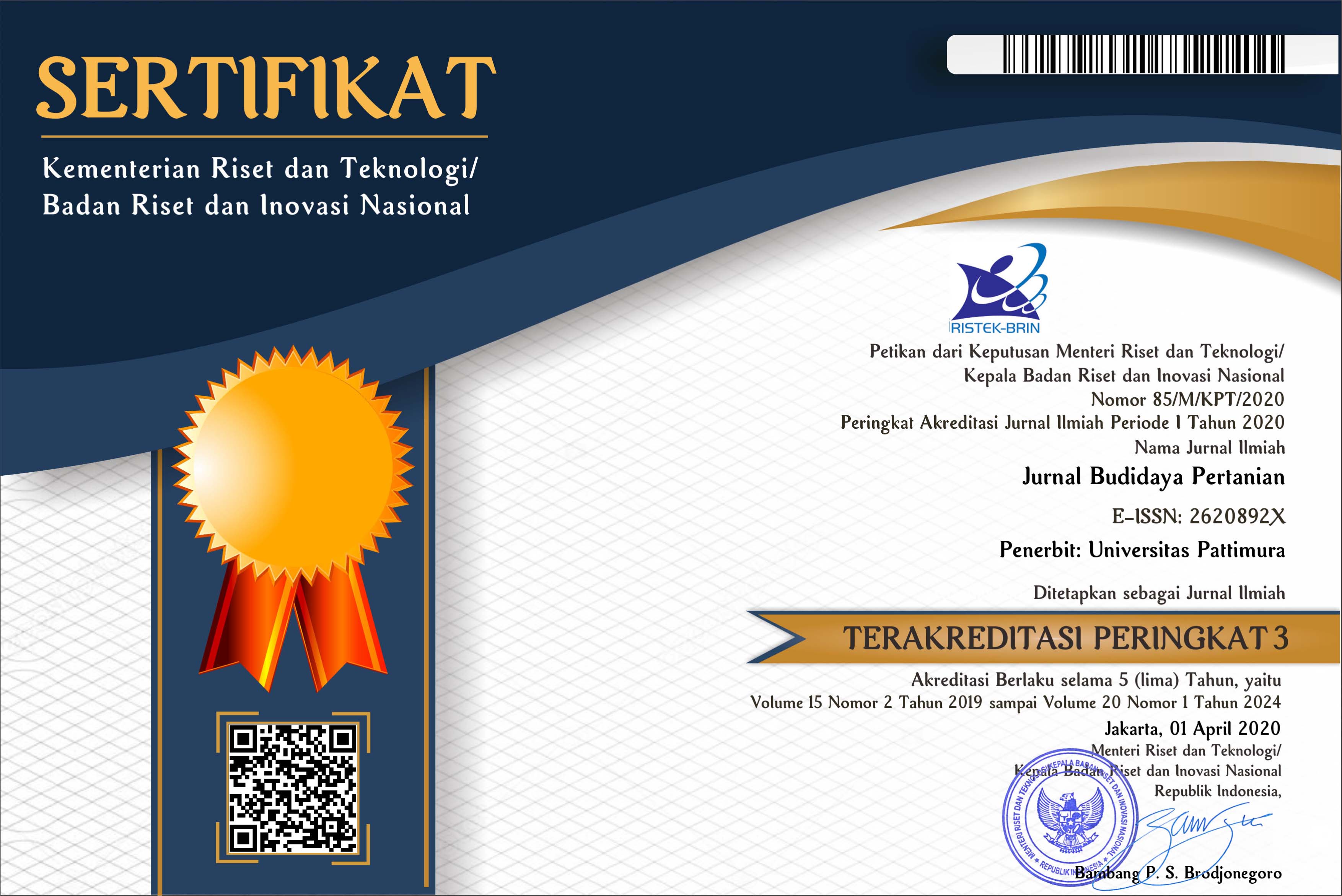Pertumbuhan dan Hasil Tanaman Bawang Merah (Allium ascalonicum L) Asal Biji (True Shallot Seeds) Pada Berbagai Macam Pupuk NPK
Growth and Yield of Shallot Plants (Allium ascalonicum L) from Seeds (True Shallot Seeds) in Various Types of NPK Fertilizer
Abstract
Shallots (Allium ascalonicum L. syn. A. cepa var. aggregatum) are a strategic commodity and has high economic value and cannot be substituted with other commodities. Currently, shallots are included in the main food commodity group, because their availability and price greatly influence inflation and the national economy. However, shallot production remains low, and planting material from tubers is expensive and susceptible to pests and diseases. The aim of this research is to increase shallot production by using planting material from True Shallot Seed (TSS) seeds through testing various types of NPK fertilizer on shallot growth and yield). This research aimed to increase shallot production by utilizing True Shallot Seeds (TSS) as planting material and evaluating the effects of various NPK fertilizer types on shallot growth and yield. The research design used was a single factor Randomized Block Design with 4 treatments and 6 replications so that there were 24 experimental units. Variables observed included plant height, number of leaves per clump, number of tubers per clump, tuber diameter, fresh tuber weight per plant, fresh weight of stover and dry weight of stover. The observation results were tested using Analysis of Variance (Anova) if there was a significant difference followed by Duncan's 5% multiple range test. The results indicated that the treatments had a highly significant effect on the growth and yield of shallot plants derived from TSS .The type of NPK fertilizer had a significant effect on the variables of plant height, number of tubers per hill, fresh weight of tubers and dry weight of plant stover and did not significantly differ on the parameters of number of leaves, diameter of tubers and fresh weight of stover. The highest yield was in the M3 (mixed NPK) treatment, namely the number of tubers was 15.89 and the fresh weight of the tubers was 164.11 gr
Downloads
References
Anam, C., Hanafi, I., & Kusumawati, D. E. (2021). Kajian macam pupuk NPK dan mulsa plastik terhadap pertumbuhan dan produksi bawang merah. Agroradix, 5(1), 1–10. https://doi.org/10.52166/agroteknologi.v5i1.2706
Arifin Z, L Aisyawati, L Anggraeni, A Krismawati and DS Trijaya.2023. Effectiveness of NPK (11-11-28) fertilizer on the growth and yield of shallot. International Conference of Green Technologi (ICGT) Conf.Series Earth and Environmental Science. https://doi.org/10.1088/1755-1315/1312/1/012045
Badan Pusat Statistik (BPS). 2021. Produksi tanaman sayuran 2021-2022. https://www.bps.go.id/id/statistics- table/2/NjEjMg==/produksi-tanaman-sayuran.html.
Basuki, R.S. (2009). Analisis tingkat preferensi petani brebes terhadap karakterisitik hasil dan kualitas bawang merah varietas lokal asal dataran medium dan tinggi. Jurnal Horti, 19(4), 475–483. https://doi.org/10.21082/jhort.v19n4.2009.p%p
Dewi, N. (2012). Untung Segudang Bertanam Aneka Bawang. Pustaka Baru Press. Yogyakarta.
Fahmi, N., Syamsuddin, dan Ainun, M. (2014). Effect of organic and inorganic fertilizer on growth and yield of sybean (Glycine max ( L. ) Merrill ). J. Floratek, 9, 53–62. https://doi.org/10.17969/floratek.v9i2.2000.
Gunadi, N. (2009). Kalium sulfat dan kalium klorida sebagai sumber pupuk kalium pada tanaman bawang merah. Jurnal Hortikultura 19 (2) :174-185.
Hamid, I. (2019). Pengaruh pemberian pupuk NPK “Mutiara” terhadap pertumbuhan dan produksi tanaman jagung (Zea mayz L). Jurnal Biosaintek, 2(1), 9–15. https://doi.org/10.52046/biosainstek.v2i01.311.9-15.
Irawan. (2017). Pengaruh pemupukan N, P dan K terhadap pertumbuhan dan hasil bawang merah (Allium ascalonicum L) varietas Bima Brebes dan Thailand di tanah ultisol. Skripsi. Fakultas Pertanian. Universitas Islam. Riau
Istina, I.N. (2014). Peningkatan produksi bawang merah melalui teknik pemupukan NPK. Jurnal Agro, 3 No 1. https://www.journal.uinsgd.ac.id/index.php/ja/article/view/810 . https://doi.org/10.15575/810
Ma'ruf, M., Nelvia, N., & Silvina, F. (2019). Pengaruh pemberian pupuk hayati dan pupuk N, P, K terhadap pertumbuhan dan produksi tanaman bawang merah (Allium ascalonicum L.). Jurnal Agroteknologi, 10(2), 1-10. https://doi.org/10.24014/jat.v10i2.5628
Napitupulu, D and L. Winarto. (2010). Effect of N and K fertilizers on growth and Pproduction of shallots. Journal of Horticulture, 20 (1) :27-35.
Pangestuti, R. and Endang, S. (2011). Potensi penggunaan true shallot seeds (TSS ) sebagai sumber benih bawang merah di Indonesia. Prosiding Semiloka Nasional “Dukungan Agro-Inovasi untuk Pemberdayaan Petani, Kerjasama UNDIP, BPTP Jateng, dan Pemprov Jateng, Semarang 14 Juli 2011258– 266.
Prayudi, B., Pangestuti, R., dan Kusumasari, A.C. (2020). Produksi umbi mini bawang merah asal true shallot seeds (TSS). Sidomulyo: Balai Pengkajian Teknologi Pertanian Jawa Tengah.
Pujiati, Primiani C.N. & Matheny 2017. Budidaya Bawang Merah Pada Lahan Sempit. Program Studi Pendidikan Biologi, FKIP Universitas PGRI, Madiun
Purba. R. (2014). Applications of NPK phonska and KCl fertilizer for the growth and yield of shallots (Allium Ascalonicum) in Serang, Banten. International Journal of Applied Sciense and Technology. 4(3), 197–203
Sari, L.W., Anwar, S., & Fuskhah, E. (2022). Pertumbuhan tanaman bawang merah asal true shallot seed terhadap aplikasi berbagai dosis pupuk kalium dan trichokompos kotoran ayam. Agroeco Science Journal, 1(1), 1-10. https://ejournal2.undip.ac.id/index.php/aesj/article/view/16526
Sipahutar, J. (2020). Pengaruh pemberian beberapa kombinasi pupuk (Urea, TSP, KCl) dan abu janjang kelapa sawit terhadap pertumbuhan serta produksi tanaman bawang merah (Allium ascalonicum L). Skripsi. Fak.Pertanian Universitas Islam Riau.
Sumarni, N., Sopha, G.A. and Gaswanto,R. (2012). Respons tanaman bawang merah asal biji true shallot seeds terhadap kerapatan tanaman pada musim hujan. Jurnal Horti, 22(1), 23–28. https://repository.pertanian.go.id/handle/123456789/895
Swasono, F. D. H. (2012). Karakteristik fisiologi toleransi tanaman bawang merah terhadap cekaman kekeringan di tanah pasir pantai. Jurnal AgriSains, 3(4), 88-103.
Triharyanto, E., Sulistyo, T.D., & Fauziah Kumalasari, F. (2021). Pengaruh perendaman zat pengatur tumbuh alami pada perkecambahan dan pertumbuhan bibit TSS bawang merah. p 102-114. Prosiding Seminar Nasional dalam Rangka Dies Natalis ke-45 UNS Tahun 2021.
Copyright (c) 2025 Kharis Triyono, Sartono J Santosa, Elly E Maulida

This work is licensed under a Creative Commons Attribution-ShareAlike 4.0 International License.

 Accreditation is valid for 5 years, starting from Volume 15 Issues 2 December 2019 up to Volume 20 Issue 1 June 2024.
Accreditation is valid for 5 years, starting from Volume 15 Issues 2 December 2019 up to Volume 20 Issue 1 June 2024.






